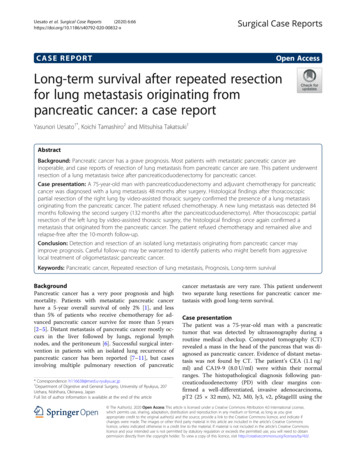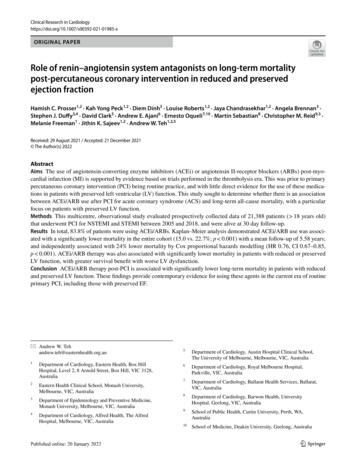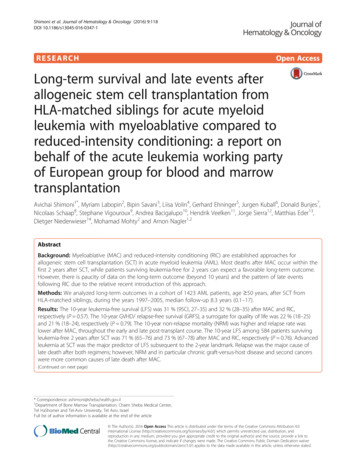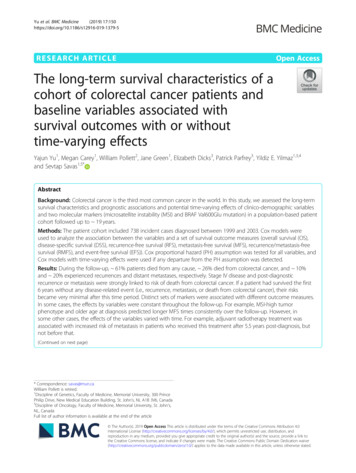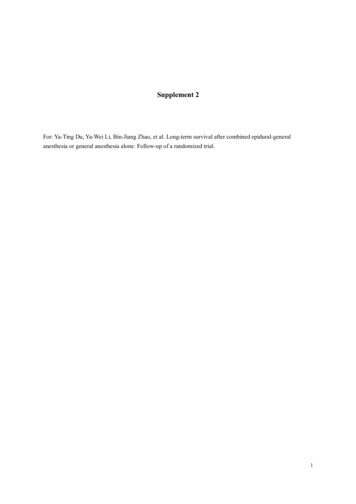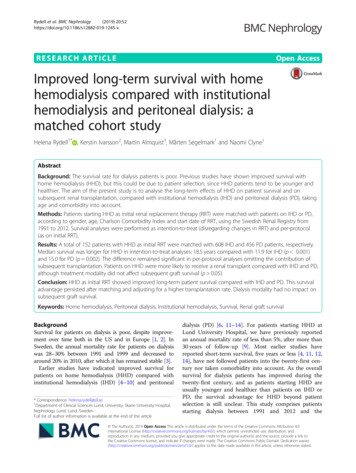
Transcription
Rydell et al. BMC Nephrology(2019) ARCH ARTICLEOpen AccessImproved long-term survival with homehemodialysis compared with institutionalhemodialysis and peritoneal dialysis: amatched cohort studyHelena Rydell1* , Kerstin Ivarsson2, Martin Almquist3, Mårten Segelmark1 and Naomi Clyne1AbstractBackground: The survival rate for dialysis patients is poor. Previous studies have shown improved survival withhome hemodialysis (HHD), but this could be due to patient selection, since HHD patients tend to be younger andhealthier. The aim of the present study is to analyse the long-term effects of HHD on patient survival and onsubsequent renal transplantation, compared with institutional hemodialysis (IHD) and peritoneal dialysis (PD), takingage and comorbidity into account.Methods: Patients starting HHD as initial renal replacement therapy (RRT) were matched with patients on IHD or PD,according to gender, age, Charlson Comorbidity Index and start date of RRT, using the Swedish Renal Registry from1991 to 2012. Survival analyses were performed as intention-to-treat (disregarding changes in RRT) and per-protocol(as on initial RRT).Results: A total of 152 patients with HHD as initial RRT were matched with 608 IHD and 456 PD patients, respectively.Median survival was longer for HHD in intention-to-treat analyses: 18.5 years compared with 11.9 for IHD (p 0.001)and 15.0 for PD (p 0.002). The difference remained significant in per-protocol analyses omitting the contribution ofsubsequent transplantation. Patients on HHD were more likely to receive a renal transplant compared with IHD and PD,although treatment modality did not affect subsequent graft survival (p 0.05).Conclusion: HHD as initial RRT showed improved long-term patient survival compared with IHD and PD. This survivaladvantage persisted after matching and adjusting for a higher transplantation rate. Dialysis modality had no impact onsubsequent graft survival.Keywords: Home hemodialysis, Peritoneal dialysis, Institutional hemodialysis, Survival, Renal graft survivalBackgroundSurvival for patients on dialysis is poor, despite improvement over time both in the US and in Europe [1, 2]. InSweden, the annual mortality rate for patients on dialysiswas 28–30% between 1991 and 1999 and decreased toaround 20% in 2010, after which it has remained stable [3].Earlier studies have indicated improved survival forpatients on home hemodialysis (HHD) compared withinstitutional hemodialysis (IHD) [4–10] and peritoneal* Correspondence: Helena.rydell@sll.se1Department of Clinical Sciences Lund, University, Skane University Hospital,Nephrology Lund, Lund, SwedenFull list of author information is available at the end of the articledialysis (PD) [6, 11–14]. For patients starting HHD atLund University Hospital, we have previously reportedan annual mortality rate of less than 5%, after more than30 years of follow-up [9]. Most earlier studies havereported short-term survival, five years or less [4, 11, 12,14], have not followed patients into the twenty-first century nor taken comorbidity into account. As the overallsurvival for dialysis patients has improved during thetwenty-first century, and as patients starting HHD areusually younger and healthier than patients on IHD orPD, the survival advantage for HHD beyond patientselection is still unclear. This study comprises patientsstarting dialysis between 1991 and 2012 and the The Author(s). 2019 Open Access This article is distributed under the terms of the Creative Commons Attribution 4.0International License (http://creativecommons.org/licenses/by/4.0/), which permits unrestricted use, distribution, andreproduction in any medium, provided you give appropriate credit to the original author(s) and the source, provide a link tothe Creative Commons license, and indicate if changes were made. The Creative Commons Public Domain Dedication o/1.0/) applies to the data made available in this article, unless otherwise stated.
Rydell et al. BMC Nephrology(2019) 20:52matching is performed with a comorbidity index, whichis a composite measure for comorbidity.Patients eligible for HHD are most often also eligiblefor renal transplantation. There are, to our knowledge,no previous reports studying the effects of dialysismodality on subsequent renal graft survival.The primary aim of this study was to comparelong-term survival for patients with HHD as initial renalreplacement therapy (RRT) with matched control patientswith either IHD or PD as initial RRT. The secondary aimwas to compare subsequent renal graft survival forpatients with either HHD, IHD or PD as initial RRT.MethodsDefinitions of initial renal replacement therapyHHD, IHD or PD as initial RRT were defined as the modality registered in the Swedish Renal Registry (SRR) atday 90 after start of RRT. A failing renal transplant or aperiod of recovered renal function before day 90 wereexclusion criteria. To be defined as HHD as first RRT, apatient was not allowed to have received PD before day90. To be defined as PD, a patient was not allowed tohave had HHD before day 90. To be defined as IHD, noother RRT was allowed during the first year after start ofRRT, except for transplantation after day 90 (Fig. 1).Inclusion criteriaAll patients 18 years or older, registered in the SRR andstarting RRT between January 1st 1991 and December31st 2012 were eligible for inclusion if they fulfilled thecriteria of HHD, IHD or PD as initial RRT.MatchingWe created two matched control sets by matching HHDpatients separately with PD (1:3) and IHD (1:4) patients.Gender, Charlson Comorbidity Index, age ( / 3 years)Page 2 of 9and date for start of RRT ( / 3 years) were used asmatching criteria. Matching was performed at day 0 ofRRT. Matching was performed in loops starting with theHHD patients with the least possible matches. The loopscontinued as long as there were controls fulfillingmatching criteria for all HHD patients.Charlson Comorbidity Index [15] was defined using alldischarge diagnoses in the Swedish Inpatient Registryuntil the start date of RRT as previously described [16].Data collectionStart dates and the dates of changes in RRT, dates ofbirth and renal diagnoses were collected from the SRR.Discharge diagnoses and dates of hospital admissionswere collected from the Swedish Inpatient Registry.Dates of death were collected from the Swedish Mortality Database.Patient survivalSurvival was calculated from day 0 of RRT. All patientswere followed until death or December 31st 2013. Nopatient was registered as lost to follow-up in the SRR.Two different survival analyses were performed. Inintention-to-treat analysis (ITT), patients were considered at risk also after switching to other RRT. As renaldiagnosis was not considered in the matching, it wasincluded in a bivariable Cox regression ITT survivalanalysis. A sensitivity analysis was performed withcensoring at recovery of native renal function.In addition, two different per-protocol analyses wereperformed: “on initial RRT” analysis with censoringfor all switches from the group modality and “ondialysis treatment” analysis with censoring at renaltransplantation, recovered native renal function andend of study.Fig. 1 Inclusion and exclusion of matched patients with HHD, IHD and PD as initial renal replacement therapy
Rydell et al. BMC Nephrology(2019) 20:52Subsequent renal transplantationRenal graft survival was studied in all patients who had asubsequent renal transplantation and in a subgroup ofpatients who had a renal transplantation while still ontheir initial RRT. As the subgroups with subsequenttransplants were not matched, multivariable Cox regression analysis was performed including decade of start ofRRT, gender, age and Charlson Comorbidity Index atday 0 for RRT, renal diagnosis, dialysis vintage at thedate of transplantation and whether the graft was from aliving or deceased donor. Graft failure was defined asthe only event in this analysis. Censoring was performedat date of death and at end of study.Page 3 of 9Table 1 Patient characteristics at start of renal replacementtherapy in a cohort of Swedish HHD patients and two matchedcontrol cohorts of IHD and PD patientsHHDIHDPD152608456 1991–199952% (79)48% (290)48% (221) 2000–200936% (54)42% (253)42% (193) 2010–201213% (19)11% (65)9% (42)Median age(IQR) �58.0)Gender male percent (n)82% (124)82% (496)82% (372)Patients numberYear of start percent (n)Charlson index percent (n)Statistical analysis 063% (95)63% (380)63% (285)Calculations of Charlson Comorbidity Index were performed using STATA software version 12. Definitions ofgroups and matching were made using SAS. All survivalanalyses were performed with IBM SPSS version 23.For both patient and renal graft survival analysis,Kaplan Meier curves were used as well as multivariableCox regression analyses. Log rank test was used forcomparison of patient survival. Descriptive data and survival are given as medians, interquartile ranges (IQR)and means. 128% (42)28% (168)28% (126) 28% (12)8% (48)8% (36) 32% (3)2% (12)2% (9)10% (15)20% (123)27% (122)Renal diagnosis percent (n) Diabetes mellitus Glomerulonephritis30% (46)25% (149)28% (126) Hypertension6% (9)7% (43)5% (23) APCKDa15% (23)10% (62)9% (43) Pyelonephritis4% (6)3% (21)3% (12)Results Other28% (43)23% (138)20% (89)Patient characteristics Unspecified6% (10)12% (72)9% (41)During 1991 to 2012, 152 patients started RRT in Swedenwith HHD as their initial treatment modality, according tothe criteria used in this study. Their mean age was 50.2years and 82% were male. A Charlson Comorbidity Indexwas assigned retrospectively to each patient using hospitaldischarge diagnoses. Most patients had an index of 0(63%), 28% had an index of 1, 8% had an index of 2 and2% an index of 3 (Table 1).This cohort of incident HHD patients was comparedwith two matched cohorts - one starting on IHD and onestarting on PD. Matched controls were recruited for eachHHD patient, generating an IHD cohort of 608 and a PDcohort of 456 patients. As shown in Table 1, the cohortswere well-matched with respect to age, gender andco-morbidity index.The most common renal diagnosis was glomerulonephritis in all three groups followed by adult polycystickidney disease for HHD and diabetic nephropathy forthe IHD and PD patients (Table 1).Changes in RRT during follow-upMedian follow-up duration was 10.4 years for HHD(IQR 5.9–15.4), 7.0 years for IHD (IQR 2.8–12.8) and7.5 years for PD patients (IQR 3.4–13.8). According tothe definitions of initial RRT, no patient had recoveredrenal function before day 90. However, after day 90, oneaAdult polycystic kidney diseaseHHD patient, 11 IHD and six PD patients had recoveredenough renal function for a pause in dialysis treatment.Most patients changed RRT during the follow-upperiod, although 25 HHD (16%), 282 IHD (46%) and 74PD (16%) patients continued on the same dialysis modality after day 90 until death or December 31st 2013.Renal transplantation was the most common RRT subsequent to the initial dialysis modality but switchesbetween dialysis modalities were also common, resultingin several periods on the initial dialysis modality forsome patients (Table 2). Among the HHD patients, 9%had more than one period on HHD (1 to 3 periods).Among IHD and PD patients, 13% had more than oneperiod on their initial RRT. Of the HHD and PD patients, 24 and 38% respectively had one to three periodson IHD. However, switches to HHD or PD from otherdialysis modalities were uncommon. Only 2% of theIHD and 1% of the PD patients had a period on HHD,and only 12% of the IHD patients and zero HHD patientswitched to PD.Patient survivalThe HHD cohort showed a superior overall survivalcompared with the matched IHD cohort (p 0.001) and
Rydell et al. BMC Nephrology(2019) 20:52Page 4 of 9Table 2 Duration and frequency of initial and subsequent renal replacement therapies for the respective cohortsHHDIHDPDInitial RRTMedian duration (IQR) yearsFirst period with2.12.31.4HHD/IHD/PD(1.1–3.1; n 152)(1.1–3.9; n 608)(0.8–2.4; n 456)Total treatment with2.42.61.5HHD/IHD/PD(1.2–3.6; n 152)(1.3–4.9; n 608)(0.9–2.7; n 456)Other RRTMedian duration (IQR) yearsRenal transplantation8.98.68.4(5.1–13.5; n 114)(3.8–12.3; n 312)(4.3–13.1; n 311)HHD–3.2 (2.3–6.8; n 10)0.8 (0.3–0.8; n 5)IHD2.3(0.6–4.8; n 36)–3.0(0.7–8.8; n 174)PD01.7 (0.6–2.7; n 15)–the matched PD cohort (p 0.002). In this survival analysis, disregarding all changes in RRT, median survivalwas 18.5 years (IQR 10.4 - not available) for HHD patients, 11.9 years for IHD patients (IQR 3.8 - not available) and 15.0 years for PD patients (IQR 5.1 – notavailable). At the end of the study, on December 31st2013, 104 HHD (68%), 307 IHD (50%) and 256 (56%)PD patients were still alive. Five, ten and twenty years’survival was respectively 91, 76 and 49% for HHD patients; 70, 57 and 34% for IHD patients; and 76, 62 and39% for PD patients (Fig. 2, Table 3).As renal diagnosis was not included in the matching,bivariable Cox regression analyses were performed. HHDremained a factor associated with a favourable prognosisin these analyses compared with both IHD (p 0.001)and PD (p 0.033). The hazard ratio (HR) was 0.55 (95%confidence interval 0.40–0.75) for HHD in the comparison with IHD and 0.70 (0.51–0.97) in the comparison withPD. In the analysis with HHD and IHD, adult polycystickidney disease (HR 0.38; 95% confidence interval 0.22–0.64; p 0.001) and glomerulonephritis (HR 0.53; 95%confidence interval 0.35–0.78; p 0.001) were related toan improved prognosis. This was in contrast to diabetes,which was related to a worse prognosis (HR 1.94;95% confidence interval 1.33–2.84; p 0.001). In theanalysis of HHD versus PD, only diabetes wassignificantly related to survival, showing a worseprognosis (HR 2.57; 95% confidence interval 1.54–4.31; p 0.000).Survival analyses per-protocol, with censoring at allswitches from the initial RRT, were also performed toremove the contribution of subsequent transplantationand subsequent different dialysis modalities. In these oninitial RRT analyses, there were also significant survivaladvantages for HHD patients in comparison both withIHD (p 0.001) and with PD (p 0.001). Survival was66% for HHD patients at the end of study on December31st 2013 (25% quartile 8.4 years; median and 75% quartile not available). Median survival was 6.3 years (IQR2.9–11.5) for IHD and 6.1 years (IQR 3.2–6.6) for PD patients. The “on initial RRT” five years’ survival was 85%for HHD, 57% for IHD and 60% for PD patients. At 10years, only three HHD, 25 IHD and one PD patient werestill at risk. In survival analysis “on dialysis treatment”,with censoring only at the dates of renal transplantation and lost to follow-up, HHD patients also had significantly longer survival in comparison with IHD (p 0.001)and PD (p 0.001) patients (Fig. 3, Table 3).Subsequent renal transplantationSubsequent renal transplantation was more commonamong patients with HHD compared with the other modalities. During follow-up, 75% of the HHD patients,68% of the PD and 51% of the IHD patients receivedbetween one and three renal transplants (Table 2).There was no difference in subsequent renal graftsurvival between the modalities. Ten years’ graft survivalwas 75% for HHD (n 114), 72% for IHD (n 313) and75% for PD (n 311) patients, both when analysed forall patients with a subsequent renal transplantationand for the subgroups with a transplantation immediately subsequent to their initial RRT (HHD n 107, IHDn 304, PD n 219).In multivariable Cox regression analyses, there wereno significant differences in graft survival after HHDand IHD, neither in the analyses for all patients (p 0.416) nor for the subgroups of patients with renaltransplantations immediately subsequent to the initialRRT (p 0.489); nor were there significant differencesbetween HHD and PD in the comparisons with all
Rydell et al. BMC Nephrology(2019) 20:52Page 5 of 9Fig. 2 Overall survival. Superior overall survival (intention-to-treat analysis) for incident patients with HHD (n 152) as first renal replacementtherapy (RRT) compared with matched patients with IHD (n 608; p 0.001) and PD (n 456; p 0.002) as first RRT. In the analyses, changes toother modalities were not considered and censoring was only performed at the end of the studypatients (p 0.616) or the subgroups with an immediatesubsequent transplantation (p 0.297).Most other variables in the analyses were not significantly related to survival. However, in both comparisonsbetween HHD and IHD, comprising all patients andthose with a renal transplantation immediately subsequent to the initial RRT (p 0.005; p 0.006) and in thecomparison between all HHD and all PD patients (p 0.038), an earlier decade of start of RRT was significantlyrelated to a worse graft survival.DiscussionThis population-based study including all Swedishpatients with HHD as initial RRT showed an improvedlong-term survival for HHD compared with both IHDand PD. We have previously reported similar long-termresults in a single-centre population from Skåne University Hospital, for patients starting dialysis between 1983and 2002, with a five-year survival of 98% for HHD and71% for IHD patients [8]. Our results are in accordancewith most earlier studies [4–8, 10–14], albeit that thelatter have generally had shorter follow-up periods, especially those including patients during the twenty-firstcentury only [4, 12, 14]. There are two studies comparing HHD with IHD, one from New Zealand and onefrom Australia, which included patients starting RRTduring the twenty-first century and which followed themfor more than five years [7, 10].In the present study, the hazard ratio of death was0.55 (p 0.001) for incident HHD patients in comparison with IHD patients and 0.70 (p 0.033) in comparison with PD patients, using intention-to-treat analysis.The magnitude of the survival advantage reported forHHD patients in other studies is affected by differentdefinitions of dialysis modalities, inclusion criteria andmethods. One study that defined patients living and dialysing in a long-term care facility as HHD patientsshowed no survival advantage for HHD compared withIHD or PD. [17] Differences in inclusion criteria, inwhich exclusively incident or both incident and prevalent patients were accepted, can also have an impact onthe results, especially in comparison with PD. Afollow-up according to intention-to-treat or per-protocolis another methodological factor behind differences between studies. With follow-up according to per-protocol,the results are not only influenced by the initial RRT but
Rydell et al. BMC Nephrology(2019) 20:52Page 6 of 9Table 3 Survival for HHD patients and matched IHD and PDpatientsOverall survivalWith censoring only at end of studyHHDIHDPDMedian (IQR) years18.5(10.4-NAa)11.9(3.8- NAa)15.0(5.1- NAa)Comparison with HHD(p value)– 0.0010.002Mean years16.612.513.8With censoring at end of study and recovered native renal functionHHDIHDPDMedian (IQR) years18.5(10.4- NAa)12.0(3.8- NAa)15.1(5.1- NAa)Comparison with HHD(p value)– 0.0010.003Mean years16.512.613.9Survival on initial RRT onlyWith censoring at all changes from the initial modalityHHDIHDPDMedian(IQR) rison with HHD(p value)– 0.001 0.001Mean years9.88.27.3Survival on dialysis treatment onlyWith censoring at renal transplantation, recovered native renal functionand end of studyHHDIHDPDMedian(IQR) omparison with HHD(p value)–0.001 0.001Mean years8.18.06.4aNot Available, survival 25% at end of follow upbNot Available, survival 50% at end of follow upalso by the patients who change RRT and who no longerare followed, i.e. those with either an especially good orbad prognosis.Nevertheless, since more HHD patients than IHD orPD patients received a renal transplant during follow-up,we also conducted survival analyses per-protocol, withcensoring at the dates of transplantation. We found thatHHD patients still had a survival advantage comparedwith IHD and PD patients in these analyses, even thoughthe positive impact on survival of subsequent transplantation was omitted.Probably the most important explanation for the survival advantage for HHD reported in our study, as inmost other studies, is a higher dialysis dose, one of thecharacteristics of HHD. In our previous single-centrestudy, median weekly dialysis duration was 15.5 forHHD and 12 h for IHD patients [8]. Several studies have reported improved survival related to increased hemodialysisdose, in the form of both longer dialysis sessions and higherweekly frequency [18–27]. As residual renal functiondeclines, the PD dose often becomes insufficient. The smallest advantage for HHD compared with IHD or PD wasreported in studies from the US [4, 12, 14, 17]. In one ofthese studies, a subgroup analysis including only incidentpatients showed no advantage for HHD in relation to PD.[12] Residual renal function and initial GFR at start of dialysis may also have an impact. Even taking into account differences between countries concerning selection of patientsto different modalities and GFR at start of dialysis, dialysispraxis and dialysis dose most likely have a major impact.One such difference in dialysis praxis between the US andSweden is the use of a low-dialysate-flow dialysis device.This device was not approved in Sweden until 2010 and isstill not very common. In Sweden, HHD is usuallyperformed with devices similar to those used in IHD withthe capacity to provide high-flow dialysate and longduration, such as nocturnal dialysis.Extensive patient education is another characteristic ofHHD, which also has been shown to improve survivalthrough enhanced patient compliance [28–30]. This isprobably an important contributing factor to the difference in survival as compared to IHD, but also to someextent in relation to PD as the patient educationrequired to manage PD is less extensive than with HHD.Thus, both increased dialysis dose [24, 31–33] andmore extensive patient education [34–37] have positiveeffects on significant prognostic factors which impactcardiovascular mortality, the primary cause of death indialysis patients.Patient education might also affect compliance withimmunosuppression, resulting in longer graft survival.However, there was no difference in renal graft survivalfor patients starting on HHD compared with patientsstarting on PD or IHD. To our knowledge, comparisonsof renal graft survival between HHD and IHD or PD aspretransplantation modalities have not been previouslyreported. However, two earlier studies [38, 39] havereported a similar decline in GFR after renal transplantation subsequent to HHD or IHD.Because of its retrospective design, there are limitations to this study. The most important is that despitematching, there is still a risk of residual confounding, forinstance by socioeconomic factors and smoking. However, the effect of socioeconomic factors probably differsless between the modalities in Sweden than in someother countries, as healthcare is publicly funded anduniversal; the praxis and access to different RRT is relatively homogenous for the whole population. There weredifferences in the proportions of renal diagnosesbetween the groups. However, this was addressed both
Rydell et al. BMC Nephrology(2019) 20:52Page 7 of 9Fig. 3 Survival on initial RRT. Superior survival during the first renal replacement therapy (RRT) for patients with HHD (n 152) compared withmatched patients with IHD (n 608; p 0.001) and PD (n 456; p 0.001). In these analyses, censoring was performed at all changes toother modalitiesthrough matching according to Charlson comorbidityindex and through statistical adjustment. As this was aregistry study, we did not have information about GFRand other prognostic laboratory measures at start of dialysis, dialysis prescriptions and accesses, which would havebeen useful. The higher rate of renal transplantations forpatients starting with HHD could be a consequence ofresidual differences in health at start of dialysis, but itcould also be caused by a better preservation of the of thehealth by the dialysis modality. To dissect these two possibilities, a more detailed study focusing on morbidity andhospitalizations would be necessary.Nonetheless, the study has several merits. The matchingwas strict and valid albeit that registry data was used to create the comorbidity score. The completeness of the diagnoses in the Swedish Inpatient Registry are more than 99%and their validity has a positive predictive value of 85–95%[40]. As Sweden has a long tradition of high-quality registries, it was possible to follow patients over three decades.Moreover, because of a coverage of nearly 100% in all threeregistries [40, 41], all Swedish patients starting HHD asinitial RRT during the study period could be included.ConclusionThis study showed a significant long-term survival advantage for patients starting HHD as initial RRT comparedwith IHD and PD. Subsequent renal transplantation wasmore common among patients starting HHD, but therewas no difference in subsequent renal graft survivalbetween HHD and IHD or PD as initial RRT. In mostcountries, patients treated with HHD still comprise lessthan 5% of the entire dialysis population [1]. The results ofthis study should encourage increased use of HHD in orderto improve the long-term prognosis for dialysis patients.AbbreviationsGFR: Glomerular filtration rate; HHD: Home hemodialysis; IHD: Institutionalhemodialysis; PD: Peritoneal dialysis; RRT: Renal replacement therapy;SRR: Swedish Renl RegistryAcknowledgementsThe authors would like to thank the grant givers.FundingHelena Rydell has received grants from Skåne Regional Council, TheSouthern Health Care Region, Paul Frankenius Foundation and SwedishSociety of Nephrology. The grant givers had no impact on the study design,collecting, analysis or interpretation of data or on writing of the manuscript.
Rydell et al. BMC Nephrology(2019) 20:52Availability of data and materialsThe datasets generated and/or analysed during the current study areavailable from the corresponding author on reasonable request.Authors’ contributionsAll authors contributed to the study design. MA contributed with animportant epidemiologic perspective. KI assigned Charlson ComorbidityIndex to patients. HR performed all the analyses and prepared themanuscript together with NC and MS. All authors revised the manuscript.Ethics approval and consent to participateThe study was approved by the Regional Ethical Review Board in Lund(2014/933). In this study we only used registry data. According to Swedishlaw Quality Registries can be used for research. Patients are informed andhave a right to decline to be registered, but no additional consent isrequired for specific projects.Consent for publicationNot applicable.Competing interestshe authors declare that they have no competing interests.Publisher’s NoteSpringer Nature remains neutral with regard to jurisdictional claims inpublished maps and institutional affiliations.Author details1Department of Clinical Sciences Lund, University, Skane University Hospital,Nephrology Lund, Lund, Sweden. 2Department of Clinical Sciences Lund,Pediatric psychiatry, Lund University, Skane University Hospital, Lund,Sweden. 3Department of Clinical Sciences, Lund University, Skane UniversityHospital Lund Surgery, Lund, Sweden.Received: 3 October 2018 Accepted: 1 February 2019References1. USRDS Annual report 2016. https://www.usrds.org.2. ERA-EDTA Annual report 2015. https://www.era-edta-reg.org.3. Swedish Renal Registry Annual Report 2016. https://www.medscinet.net/snr.4. Weinhandl ED, Liu J, Gilbertson DT, Arneson TJ, Collins AJ. Survival in dailyhome hemodialysis and matched thrice-weekly in-center hemodialysispatients. J Am Soc Nephrol. 2012;23(5):895–904.5. Saner E, Nitsch D, Descoeudres C, Frey FJ, Uehlinger DE. Outcome ofhome haemodialysis patients: a case-cohort study. Nephrol DialTransplant. 2005;20(3):604–10.6. Nitsch D, Steenkamp R, Tomson CR, Roderick P, Ansell D, MacGregorMS. Outcomes in patients on home haemodialysis in England andWales, 1997-2005: a comparative cohort analysis. Nephrol DialTransplant. 2011;26(5):1670–7.7. Marshall MR, Hawley CM, Kerr PG, Polkinghorne KR, Marshall RJ, Agar JW, etal. Home hemodialysis and mortality risk in Australian and New Zealandpopulations. Am J Kidney Dis. 2011;58(5):782–93.8. Rydell H, Clyne N, Segelmark M. Home- or institutional hemodialysis? - amatched pair-cohort study comparing survival and some modifiable factorsrelated to survival. Kidney Blood Press Res. 2016;41(4):392–401.9. Rydell H, Krutzen L, Simonsen O, Clyne N, Segelmark M. Excellent long timesurvival for Swedish patients starting home-hemodialysis with and withoutsubsequent renal transplantations. Hemodial Int. 2013;17(4):523–31.10. Marshall MR, Walker RC, Polkinghorne KR, Lynn KL. Survival on home dialysisin New Zealand. PLoS One. 2014;9(5):e96847.11. Nadeau-Fredette AC, Hawley CM, Pascoe EM, Chan CT, Clayton PA,Polkinghorne KR, et al. An incident cohort study comparing survivalon home hemodialysis and peritoneal Dialysis (Australia and NewZealand Dialysis and transplantation registry). Clin J Am Soc Nephrol.2015;10(8):1397–407.12. Weinhandl ED, Gilbertson DT, Collins AJ. Mortality, Hospitalization, andtechnique failure in daily home hemodialysis and matched peritonealDialysis patients: a matched cohort study. Am J Kidney Dis. 2016;67(1):98–110.Page 8 of 913. Grant AC, Rodger RS, Howie CA, Junor BJ, Briggs JD, Macdougall AI. Dialysisat home in the west of Scotland: a comparison of hemodialysis andcontinuous ambulatory peritoneal dialysis in age- and sex-matched controls.Perit Dial Int. 1992;12(4):365–
although treatment modality did not affect subsequent graft survival (p 0.05). Conclusion: HHD as initial RRT showed improved long-term patient survival compared with IHD and PD. This survival advantage persisted after matching and adjusting for a higher transplantation rate. Dialysis modality had


